Life with the Lenovo Yoga 2 Pro
by Brett Howse on July 30, 2014 2:00 PM EST- Posted in
- Notebooks
- Lenovo
- Windows 8.1
- Yoga
High DPI display
I was rather impressed by the display on the Yoga 2 Pro. The 13.3” IPS touchscreen at 3200x1800 gives the Yoga 2 Pro one of the highest pixels per inch of any current Windows 8.1 device at 276 PPI. Running desktop applications at 3200x1800 can cause some issues, and if so the only solution at this time is to drop the resolution down to 1600x900. It usually depends on the application itself and whether it supports a HiDPI mode. Some play nice and some do not. As one might expect, in a modern application environment the high DPI brings crisp font rendering and a sense of clear graphics.
Application issues aside, all is not perfect with this display either. As we know from past reviews, high PPI devices can have a higher battery draw because the amount of backlight required to push the same amount of light through a dense display is simply higher. One solution to this problem is a Thin-Film-Transistor (TFT) made of Indium Gallium Zinc Oxide (IGZO), which can be thinner than the amorphous silicon of a standard TFT and offers better transparency than the standard TFT. Some devices (like the Razer Blade which is also 3200x1800) have chosen this method. Unfortunately, likely for cost reasons, the Yoga 2 Pro has chosen to go with an RGBW pentile pixel arrangement. The white subpixel is used to improve the brightness of the display without having to overpower the backlight, but it comes with a cost of color reproduction and contrast ratio. The early runs of the Yoga 2 Pro suffered from very bad yellows. Since the initial release, Lenovo has updated the device firmware and software to help compensate.
Out of the box image quality
With the white pixel, one of the biggest things to suffer is the contrast ratio. The maximum brightness of the screen is not very high to begin with, with 249 nits at 100% brightness. At that level of backlight, the black level is 0.5 nits, giving a meager 497:1 contrast. The brightness levels are fine for indoor use, but with blacks that bright it really hurts contrast and can be pretty noticeable when using this laptop.
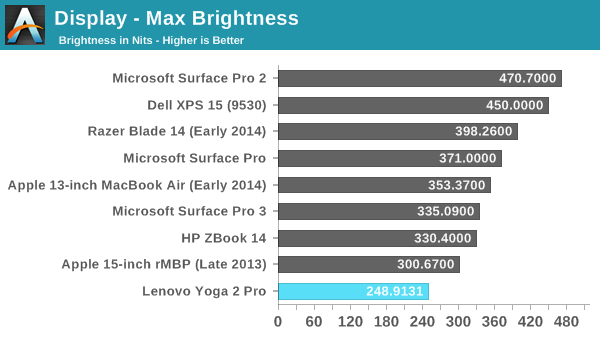
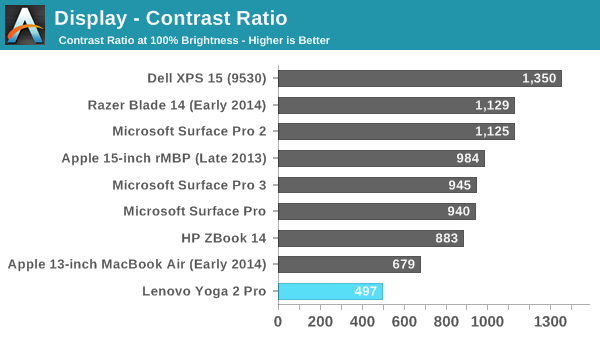
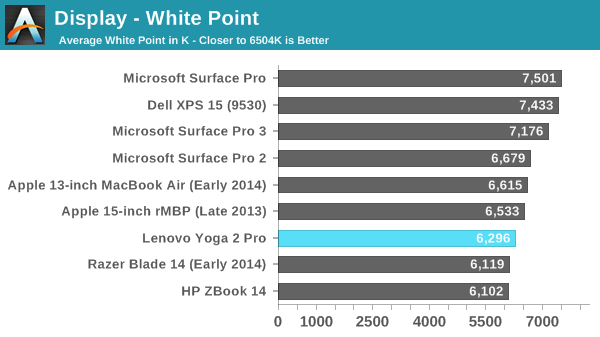
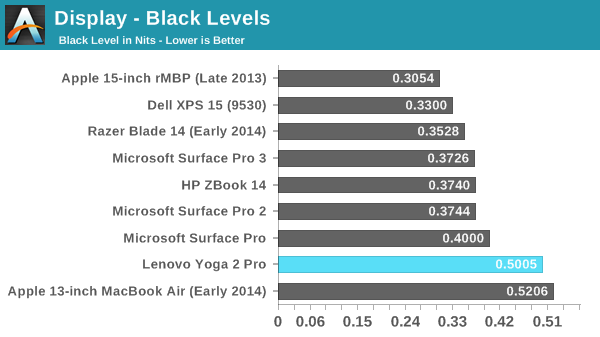
Contrast ratios aside, other elements of the display are pretty good for a consumer focused laptop. Out of the box, the greyscale DeltaE is an impressive 1.417. Blues are a bit low in the overall score, but only a bit.
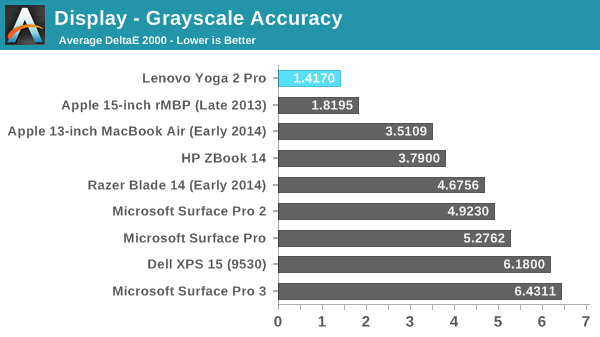
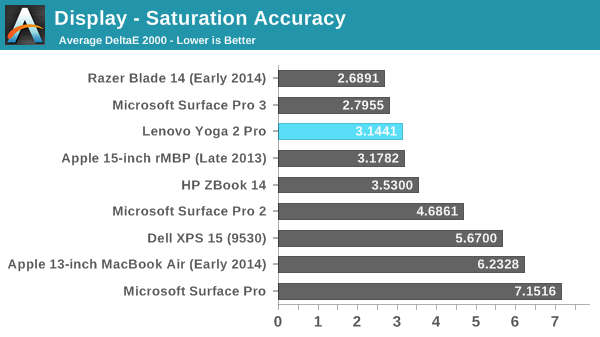
The uncalibrated saturation is also decent at 3.1441. There is definitely some drift, but it is not terrible. The yellows are spot on for saturation, which is a good sign after the firmware and software fixes to correct that. Cyan and Magenta are off, which is a theme going forward.
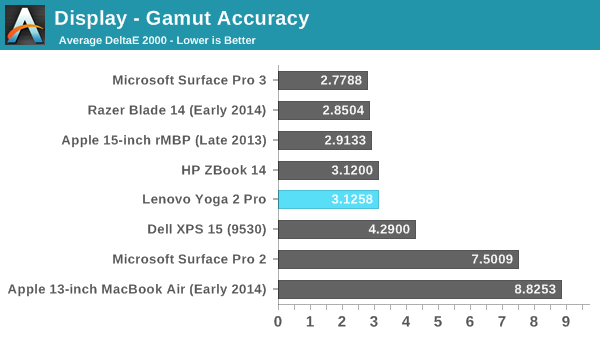
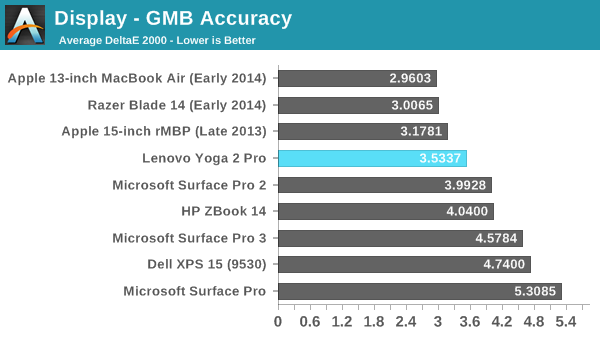
For the Gretag Macbeth colorchecker, we once again have a reasonable result of 3.5337. This device is not going to be suited for a professional image editor, but it is not really marketed as a professional device. We are looking for values under three, and the Yoga 2 Pro is close.
Calibrated image quality
Next up we will take a look at the display after it has been calibrated.
Once calibrated, the already great greyscale gets even better, with a DeltaE 2000 of 0.7834 and a white point of 6570, but that excellent result does not carry over to the rest of the display’s abilities. Cyan is again our biggest culprit, with it having a DeltaE of around 7 when the display is calibrated. This actually pulls the GMB score higher than the stock settings.
Display conclusion
Just looking at the device specifications, this should be a great display with such a high resolution. But the pentile nature of the screen can and does cause havoc with both blacks and colors. Unfortunately this display is just OK. If it was compared against most laptop panels of only a year or two ago, it would likely be a standout with both IPS and high resolution, but unfortunately it falls somewhat short. The color accuracy is not ridiculous (at least patched) but the contrast ratio really hurts, and as someone who really prefers black levels very low, it is very noticable how much light gets through on dark content. However to be fair, the redeeming quality of the display is the QHD+ resolution and to achieve that at the price point Lenovo wanted they chose to go with RGBW. It’s a compromise, but one that really does deliver on the crispness of text and images.


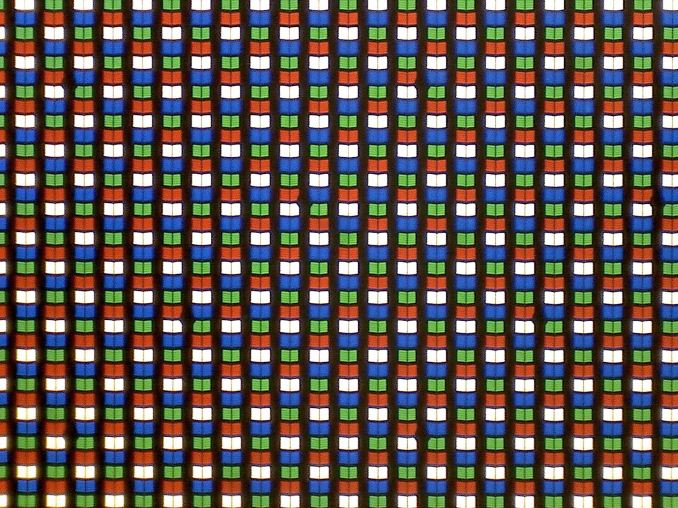
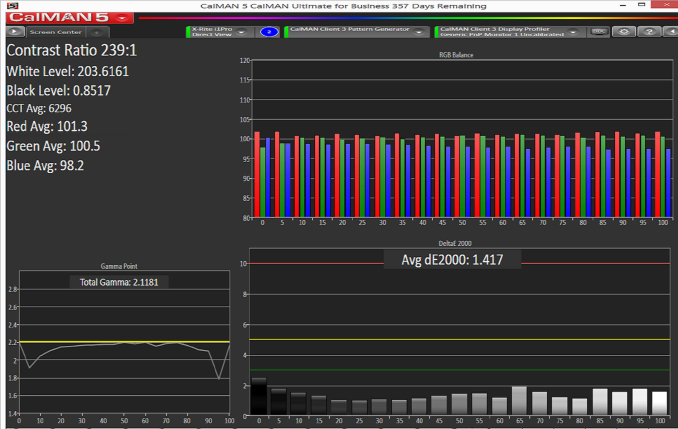





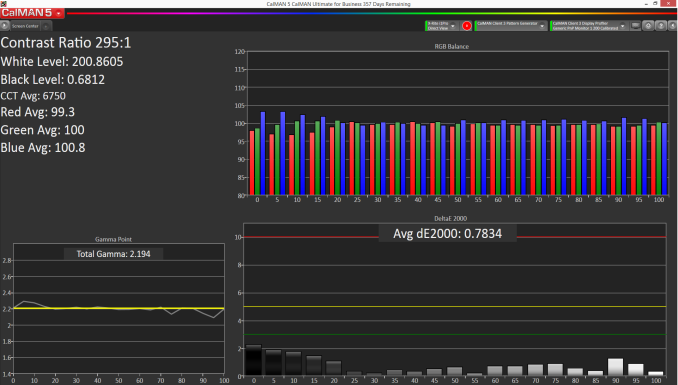











103 Comments
View All Comments
BMNify - Friday, August 1, 2014 - link
Only sub-pixel density matters to your eyes.Rdmkr - Friday, August 1, 2014 - link
"Only sub-pixel density matters to your eyes." - I disagree. Luminance detail is what matters most to the eyes and this is determined by the pixel density, not subpixel density. See http://en.wikipedia.org/wiki/Chrominance#mediaview... ; first is luminance, second chrominance.kyuu - Thursday, July 31, 2014 - link
I wish they made the 11.6" model with a 1080p IPS screen. Everything is great about it except for that damn screen. And the HDD, but I'm hoping that's replaceable (or can at least accept an M.2 like the 13" models can).And I'd prefer some AMD silicon in there, but that's just wishful thinking.
Valantar - Thursday, July 31, 2014 - link
Thanks for a great review - although others have commented on it being late, I find it interesting to get a full review with the added benefit of commentary from actual long-time usage of the device.However, I'm missing some thoughts on using this as more of a work machine rather than a consumption device, especially for more demanding tasks such as video editing. Do you have any additional thoughts here?
What kind of performance delta could one expect between this and the i7 version? In many reviews the difference in performance even between ULV Haswell i5/i7 systems and more powerful chips like the 28W versions in the MBPr 13" seems negligible (3-400 points in PCMark 7). However I'm left wondering if these tests don't tax the systems over a long enough time, so that any differences due to throttling (or inability to sustain turbo speeds) might be hiddden. Could this be the case? I'd imagine near identical performance from these systems due to both being 2C/4T with similar Turbo speeds, but the nearly 1GHz difference in stock speeds should lead to a significant difference under sustained loads, no?
The reason I'm interested in these use cases is that my fiancee needs a new laptop. She's studying filmmaking, so she wants something that would be able to run Avid Media Composer, but still is thin and light enough to carry to school every day. The calibration issues with the display don't matter as we have a professional level external monitor at home, and any really heavy work would be done on a desktop. I know the system requirements for Media Composer state that a quad core processor is required, but this would exclude the MBPr 13" as well, so I'm taking this with a grain of salt. My question is in essence this: is there any reason why the Yoga 2 Pro (i7) would not be a good fit for this kind of usage?
Brett Howse - Thursday, July 31, 2014 - link
Hi Valantar. While I haven't specifically tested the software you listed so I can't comment on how well it would run, in the benchmarks I specifically made sure to include other similar sized machines. The one closest to what you are asking about is the Acer Aspire V7-482PG-9884 (by the way I love that model name). It's got the 15 watt Haswell i7-4500U so it should be a close comparison as far as CPU performance. The GPU side is different of course because it has a GeForce GT 750M, but on the CPU benchmarks it should be fairly accurate.The performance difference isn't huge, because they are both dual core, four thread CPUs with the i5 having a base clock of 1.6 GHz and ramping to 2.6 GHz, with the i7 base at 1.8 GHz ramping to 3.0 GHz. The i7 certainly has an advantage but it's not a lot, so if you are talking about a 15 watt part, the performance is similar, but clearly lower for the i5.
Valantar - Friday, August 1, 2014 - link
Thanks for the clarification! I'm still interested in how this would compare to 28W Haswell, but I can see that AnandTech hasn't reviewed a MBPr since 2012, so I guess I'll have to look around a bit for the answer to that.As an owner of the device, how would you rate it when it comes to heavier tasks? Does it feel quick when, for example, editing a video or photos? Or would you say it's mostly suited for lighter/more consumption-oriented tasks?
CSMR - Thursday, July 31, 2014 - link
Quadrupling resolution is stupid. I wish the PC market would stop doing this.There is an optimal resolution for a screen size. Too low resolution and things do not look sharp. Too high resolution and there is needless extra cost, gpu draw and power, and incompatibility with normal resolutions for multi-monitor setups (even using an standard external screen some of the time becomes impossible).
For a 13" screen, 768p is terrible, 900p good, 1080p excellent, beyond 1080p too high.
If Windows ever becomes fully resolution-independent, then ultra-high-res becomes OK, but that requires architecture changes for working with more than one screen resolution simultaneously.
deejayshakur - Thursday, July 31, 2014 - link
Nice review on the Y2P. I came across many similar reviews discussing the high dpi, wireless card, and yellow display as being weaknesses. So I cross-shopped the Acer S7 (disliked the key configuration on a previous acer), Yoga 2 13", XPS 12 and 15, Macbook Air and ended up scoring a Yoga 2 13" in a sweet configuration from BB: i5-4210U, 8 GB of RAM, Intel 7260 AC wireless, and a 128 GB Samsung XP941 M.2 SSD (which I had no idea about until I brought the machine home). For those that don't know, the Yoga2 (non-pro) comes with the standard 1080p screen (I decided against the Y2P screen). The tradeoff with the Yoga2 is 0.5 lb. Oh, and BB had it on an .edu discount, so $899-125-10% USPS moving discount = $675 and tax.Initial thoughts: blazing fast machine for everyday tasks. Great 7-9ish hour battery life on power saver mode. PC Mark 7 basic score was 4953. Boots in 5 seconds, and wakes from hibernation in 8-10 seconds. No wifi issues so far (still in a 802.11g household). The touchpad seems to have a coating on it as everything wipes off nicely and feels soft-touch like the rest of the palm rest area.
Expansion-wise: I popped a 64 GB Transcend Jetdrive into the SDXC slot. On the Lenovo forums, people have identified an extra, internal M.2 connector, so when those drives become mainstream, there's room for more.
Most of the reviews for the Yoga 2 13 are based on a 4 GB of ram and a non-SSD. I'm glad Lenovo came out with this configuration cause for most users, I think it's the best of all worlds.
Mayuyu - Friday, August 1, 2014 - link
I got the exact same laptop and exact same deal along with Best Buy 10% rewards. The XP941 SSD was certainly a surprise. My only disappointments was the pentile screen and the inability to increase the TDP in Intel extreme tuning utility.FwFred - Thursday, July 31, 2014 - link
I can confirm I've been using the 7260 AC with no issue since last November. The replacement is fairly cheap, but it was hard to find someone selling the proper version. The swap was pretty easy except for re-attaching the antenna leads. If my fingers were about 10% of their actual size, I think it would be about right :-/